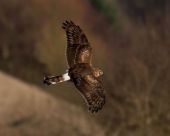
Conservation groups in Ireland call for support for farmers in Hen Harrier areas and are warning of the dangers planting trees within its protected areas. Hen Harrier has become part of a media storm in Ireland. Attempts to portray the species as a threat to farming livelihoods have been stymied by the fact that it is apparent that the interests and livelihoods of many farming communities are actually more compatible with Hen Harrier conservation than recent media reports indicate.

John Lusby, Raptor Conservation Officer with BirdWatch Ireland (BWI), commented: “Ironically, Hen Harriers are largely dependent on traditional, non-intensive farming practices. Allowing landowners in upland habitats to continue to farm appropriately would deliver significant biodiversity benefits for a range of sensitive habitats and wildlife, including Hen Harrier.”
The vilification of the species in Ireland, particularly in relation to Special Protected Areas (SPAs) designated for its conservation, needs to be addressed without delay, BWI say.
The Irish Raptor Study Group and BWI believe that better alternatives exist both within and outside Hen Harrier SPAs. Allan Mee, Chairman of the Irish Raptor Study Group, said: “Within the next Rural Development Programme … adequate support for farmers in Hen Harrier SPAs – which is typically marginal land where farm incomes are low – will be essential in balancing farming livelihoods and Hen Harrier conservation. The significant and wider environmental benefits which would be delivered through maintaining traditional, non-intensive farming practices in these upland areas need to be recognised through support to landowners, or we will be facing a situation where farming is increasingly lost, which will diminish the value and suitability of these important areas for wildlife.”
Both conservation groups are deeply concerned over mounting pressures to lift a ban on planting of forestry within the SPA network for Hen Harriers. Recent comments by the Minister of State at the Department of Agriculture, Fisheries and the Marine, Tom Hayes, indicated support for further afforestation in these protected areas, which would have a devastating effect on Ireland’s already-declining Hen Harrier population. Articles have been published in many regional newspapers calling on lifting of this restriction, despite the fines which could be imposed by the EU Commission on the Irish Government for failing to maintain the conservation status of a threatened bird species.
Between 2005 and 2010, the breeding population of Hen Harriers across the six SPAs designated for the species decreased by 18 per cent. These are areas in which the species should be thriving, and The National Parks and Wildlife Service acknowledges that further afforestation is the main pressure in the Hen Harrier SPAs.
John Lusby of BWI noted: “All of the SPAs are already heavily forested, with over half of this land comprised of commercial forestry, compared with just 11 per cent outside of SPAs. Although Hen Harriers can use the early growth stages of plantation forests for nesting and foraging, as the forest matures and the forest canopy closes their use by harriers for nesting ceases and this habitat becomes entirely unsuitable.”
Ironically, a Threat Response Plan outlining actions required by the authorities to cease, avoid, reverse, reduce, eliminate or prevent threats on the Hen Harrier is due to be finalised in June 2015 by the National Parks and Wildlife Service (Department of the Arts, Heritage and the Gaeltacht).





